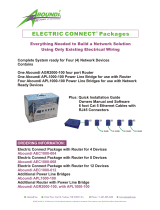
- 2 -
Overview
The ToughNet TN-5916 is a high performance M12 Layer 3 NAT Router
that supports Layer 3 routing functionality to facilitate the deployment of
applications across networks. The TN-5916 NAT router uses M12 and
other circular connectors to ensure tight, robust connections and
guarantee reliable operation against environmental disturbances, such as
vibration and shock. The TN-5916 NAT router supports isolated power in
the 24 to 110 VDC power input range, allowing the same model to be used
at different sites around the globe, and provides up to 16 Fast Ethernet
M12 ports with 4 bypass relay ports. Furthermore, with a -40 to 75°C
operating temperature and IP54-rated waterproof enclosure, the router
can be deployed in harsh environments. The TN-5916 series Ethernet
routers are compliant with EN 50155/50121-4 requirements, making the
router suitable for a variety of industrial applications.
Package Checklist
Your ToughNet TN-5916 NAT router is shipped with the following items. If
any of these items is missing or damaged, please contact your customer
service representative for assistance.
• 1 Moxa ToughNet NAT router
• M12 to DB9 console port cable
• 2 protective caps for console and relay output ports
• Panel mounting kit
• CD-ROM with user’s manual, Windows utility, and SNMP MIB file
• Quick installation guide (printed)
• Warranty card
Features
Anti-Vibration Circular Connectors for Robust Links
• M12 D-coding 4-pin female connectors for Fast Ethernet
10/100BaseT(X) ports.
• M12 A-coding 5-pin male connectors for console and relay output.
• M23 6-pin male connector for power input.
Dual Isolated Power Inputs
• 24 to 110 VDC (16.8 to 137.5 VDC), isolated.
Designed for Industry-specific Applications
• Bypass relay ensures non-stop data communication in the event the
router stops working due to a power failure.
• EN 50155/50121-3-2 compliant. See specs for details about
compliance with specific parts of the EN 50155 specifications.
• -40 to 75°C operating temperature range.
• IP54, rugged high-strength case.
• Panel mounting or DIN-rail mounting installation capability.
















